The evolution of Thayer Street
Explore business turnover on Thayer since 2000 with The Herald’s timeline
BY RHEA RASQUINHA,AND STELLA
MEHTANEIL
CHEN METRO AND U. NEWS EDITORS, SENIOR STAFFWRITER
In the last few years alone, businesses on Thayer Street have come and gone while navigating the challenges of a global pandemic — from hiring shortages to financial troubles — and the adjustment to a post-pandemic economy, which brought supply chain challenges and inflation as restrictions eased.
These changes are just the latest in the street’s long history and ongoing evolution as a business and community hub on College Hill.
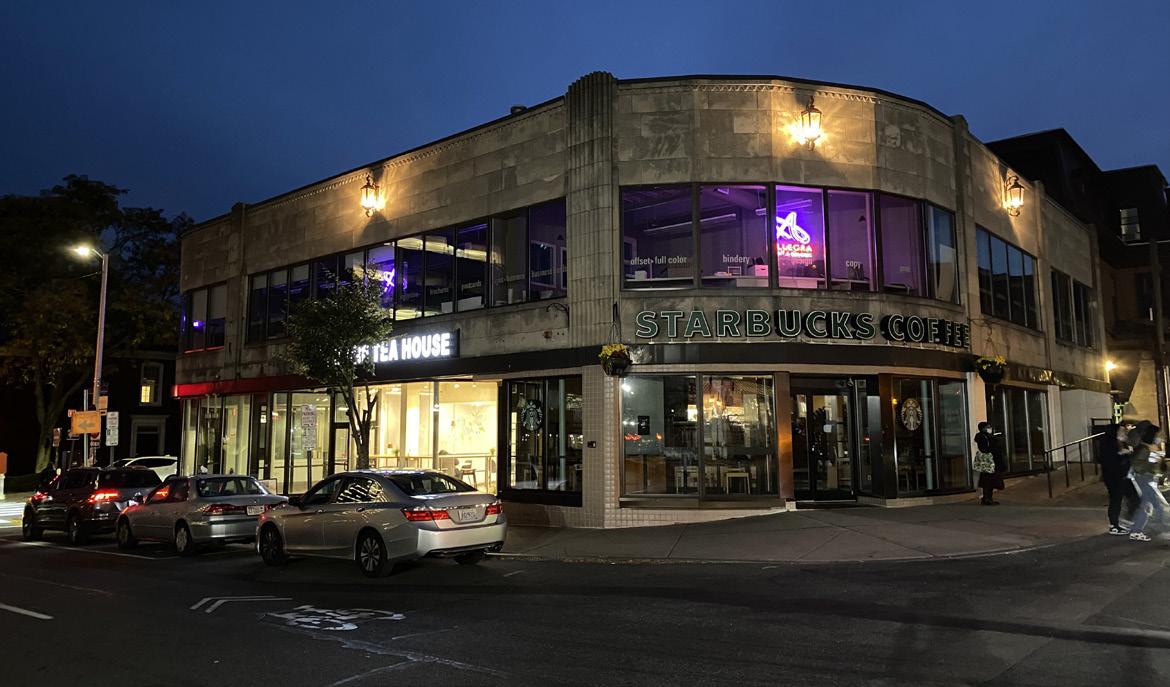
A changing street
Since the 1970s, the street has seen an influx of restaurants and a departure of small businesses — a change that some Thayer long-timers
UNIVERSITY NEWS
dislike and others welcome.

When Ann Dusseault, owner of the now-closed jewelry and gift boutique Pie in the Sky, moved the store to Thayer in 1995, the street was packed with “florists and record stores, different bookstores … skate shops, comic books (and) everything,” she said.
“It was a cool street,” she added.
“It had all indies.”
Dusseault initially opened Pie in the Sky in 1993 at 183 Angell St.
“We did everything to try to get peo -
Activist Coalition calls for Brown to pay more to city
Students demand $15 million in voluntary payments, support for Providence schools
BY RYAN DOHERTY AND ASHLEY CAI SENIOR STAFF WRITERSAround 100 students, faculty and community members gathered on the Quiet Green with loudspeakers and microphones Friday to demand that the University increase its voluntary payments to Providence. The rally was organized by the Brown Activist Coalition, which is an alliance of several student advocacy groups on campus.
At the protest, BAC called for the University to pay $15 million annually to the city of Providence — a “meager amount compared to what they owe,” according to Niyanta Nepal ’25, co-president of Students for Educational Equity and a lead organizer of the rally.
As a non-profit, the University does not pay property taxes on its educational buildings but does on


its commercial holdings. Last year, a report from the Providence Finance Department and the Office of then-Mayor Jorge Elorza estimated the University would pay almost $50 million if it were taxed on all of its property holdings, The Herald previously reported. The University is currently expected to pay $4.5 million in voluntary payments to the city this fiscal year.
The demonstration intentionally coincided with A Day on College Hill, the University’s admitted students day, according to student activists. “I think (the University) is going to feel a little bit more nervous about the power of student voices when it takes place in front of a bunch of prospective students,” Nepal said.
Speakers at the rally compared the wealth of the University to that of Providence and its public schools.
Hope High School has used bonds to “make sufficient repairs” because its facilities are “crumbling,” said State Rep. David Morales MPA’19 (D-Providence). But
ple to walk off Thayer Street to us,” she said. Even with “crazy signage and sandwich boards,” Dusseault explained, “it was still hard to get people to come.”
But today, with the disappearance of independent shops, Thayer is “all food,” she said.
According to Dusseault, the University’s presence has also impacted the street. In May 2003, Brown and a coalition of Thayer businesses an -
UNIVERSITY NEWS
Admitted
First R.I. harm reduction center to open in 2024
METRO Project Weber/RENEW, CODAC Behavioral Healthcare will launch center
BY JACOB SMOLLEN METRO EDITORThe first state-regulated overdose prevention center in the nation will open in Providence in early 2024, according to a Tuesday press release by Project Weber/RENEW, a Providence-based nonprofit harm reduction organization. Project Weber/RENEW will launch the center in partnership with CODAC Behavioral Healthcare, an outpatient opioid treatment nonprofit.
Overdose prevention centers, also commonly referred to as harm reduction centers or supervised injection sites, are locations where individuals can use illicit drugs under the watch of medical professionals and other “trained staff,” who may also provide other forms
of recovery assistance.
Project Weber/RENEW and CO -
DAC were selected to open the location by the R.I. Executive Office of Health and Human Services after EOHHS put out a request for proposals for a site in November 2022, The Herald previously reported. The center will be funded by $2.6 million the state received as part of a national settlement with three major opioid distributors.
The new facility still awaits approval from the Providence City Council and the Rhode Island Department of Health in order to move forward.
The center’s creation follows the extension of Rhode Island’s harm reduction pilot program. The original bill, passed in 2021, made Rhode Island the first state to provide temporary approval for an overdose prevention center until March 1, 2024, The Herald previously reported. Recently passed legislation has delayed the pilot’s
ADOCH hosted amidst student activism
BY OWEN DAHLKAMP SENIOR STAFF WRITERThe University hosted the second admitted students’ day, known as A Day on College Hill, for the Class of 2027 Friday. ADOCH events included a discussion about the open curriculum with Dean of the College Rashid Zia ’01, speed friending with other admitted students and tours of first-year residence halls.
Associate Provost for Enrollment Logan Powell estimated that approximately 560 students registered for each ADOCH program. He highlighted the increased financial support offered to attendees, including “expanding the travel grant program to be able to invite hundreds of low-income students to campus.”
Much of ADOCH was held on the Main Green — which was bustling throughout the day, with student activist groups hosting protests, tabling and showcasing art installations.
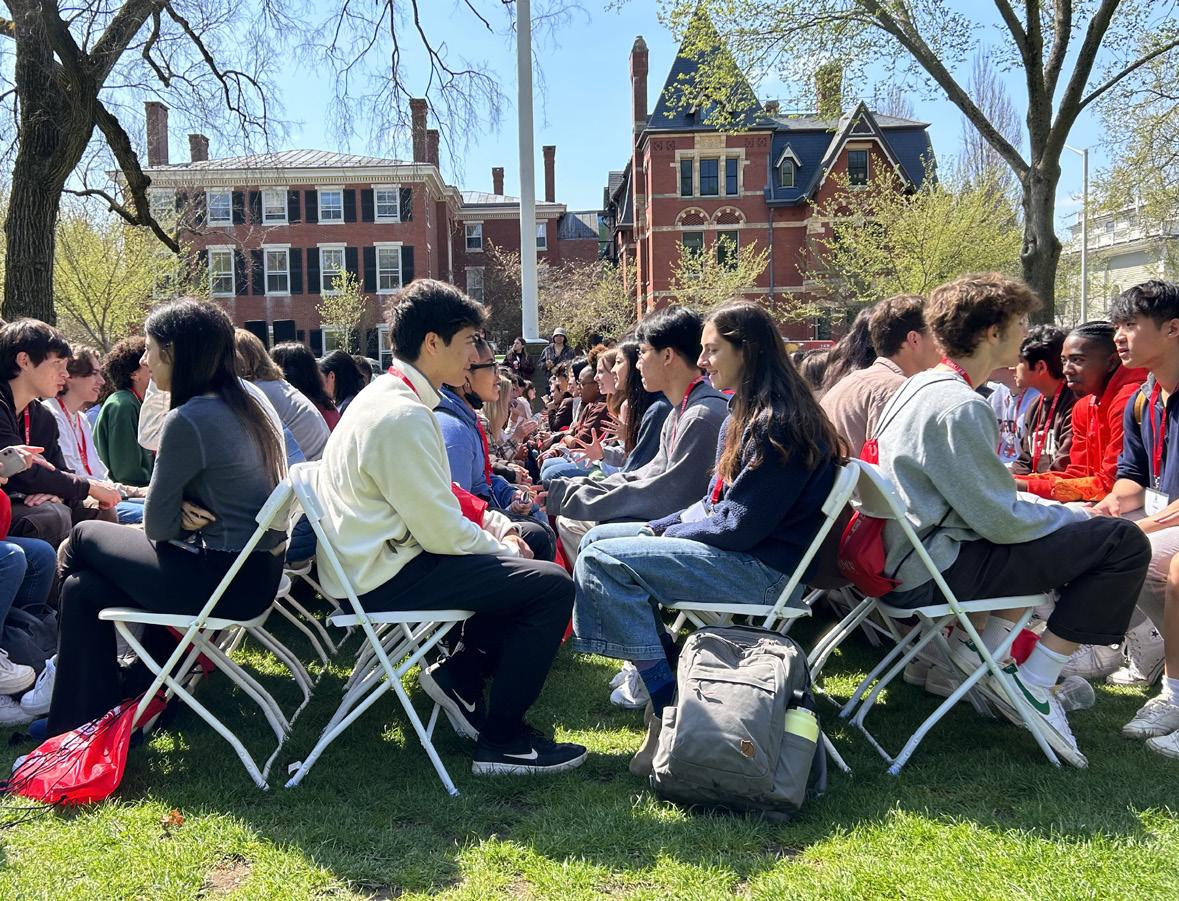
During ADOCH’s lunch period, Sunrise Brown and Students for Educational
Equity hosted a rally calling for increased voluntary payments from the University to the city of Providence. Organizers hoped the rally would educate prospective students “about how activist culture is a real thing here” and also “put some pressure” on University administrators, according to See Co-President Niyanta Nepal ’25.
to see the presence of student activists on campus.
“I’m inspired seeing the students get together and support a common cause,” Maxwell Dassow, an ADOCH attendee, said about the protest.
For Gloria Kuzmenko-Latimer, another prospective student, the protest demonstrated that “people here are very vocal about the issues that are going on in the world.”
SEE PROTEST PAGE 2 SEE ADOCH PAGE 5
Starting on the Quiet Green and later marching to University Hall, the protest caught the eye of prospective students, many of whom said they were excited
Konigsmark ’26: Brown should ban fossil-fuel recruiting on campus Page 4
student day included curriculum discussion, speed friending, dorm toursOWEN DAHLKAMP / HERALD Over 1,100 students attended the two days of ADOCH. Most of the programming was held on the Main Green. HERALD FILE PHOTO Thayer Street sees regular turnover year to year, with only 11 stores remaining on the street today that were also there in 2000. SEE THAYER PAGE 7 SEE CENTER PAGE 5
“Brown University seems to be developing a new building every other month.”
In her speech at the rally, Nepal described a “lack of basic necessities” in Providence public schools, citing a Johns Hopkins University report that found issues and deficiencies such as lead-contaminated water.
“Brown has for decades been the largest voluntary contributor to the city of Providence, and we recognize and appreciate that direct payments are one important way in
which we can provide support to our home community,” wrote University Spokesperson Brian Clark in an email to The Herald.
The University’s current voluntary payment agreements with the city expire in June, and negotiations for a new agreement are currently underway.
In a campus talk last week, Mayor Brett Smiley said that Brown and other non-profit, tax-exempt institutions “should be paying more” to the city.
“We are in conversation with city leaders as we speak on what our con -
tributions will look like in the years to come,” Clark wrote.
BAC’s campaign to encourage the University to increase voluntary payments to Providence was inspired by the New Haven community’s successful drive to increase Yale’s payments to the city. In 2021, Yale signed an agreement that would increase its contributions by $52 million over six years.
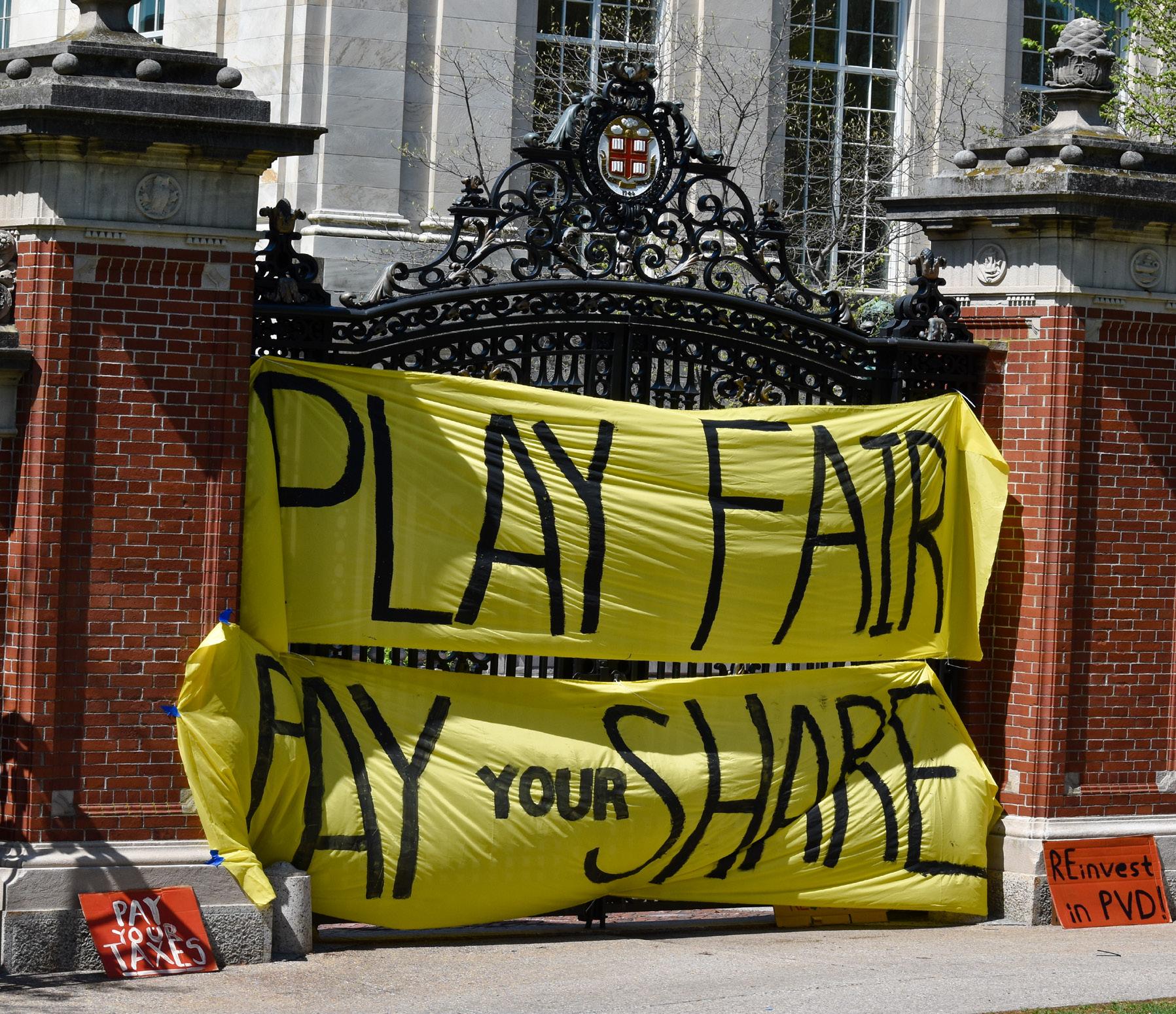
After a series of speeches, the crowd marched to University Hall to deliver an open letter to the administration as prospective students attending ADOCH looked on. The
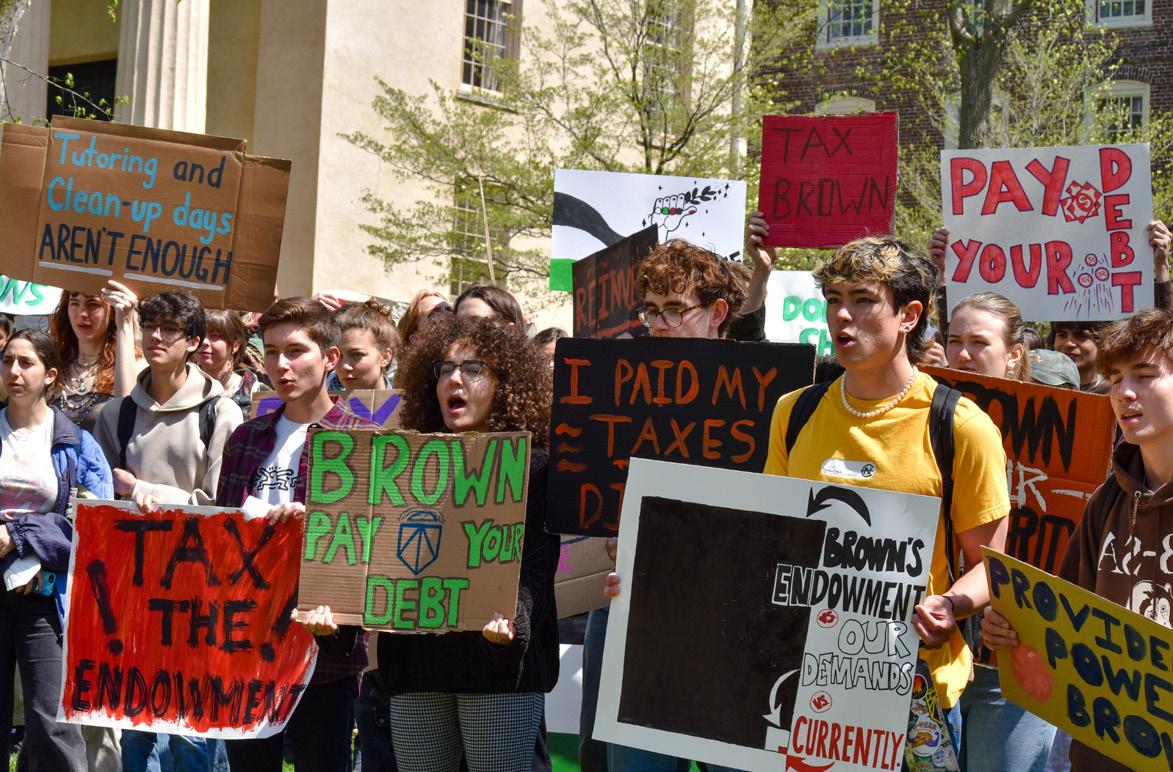
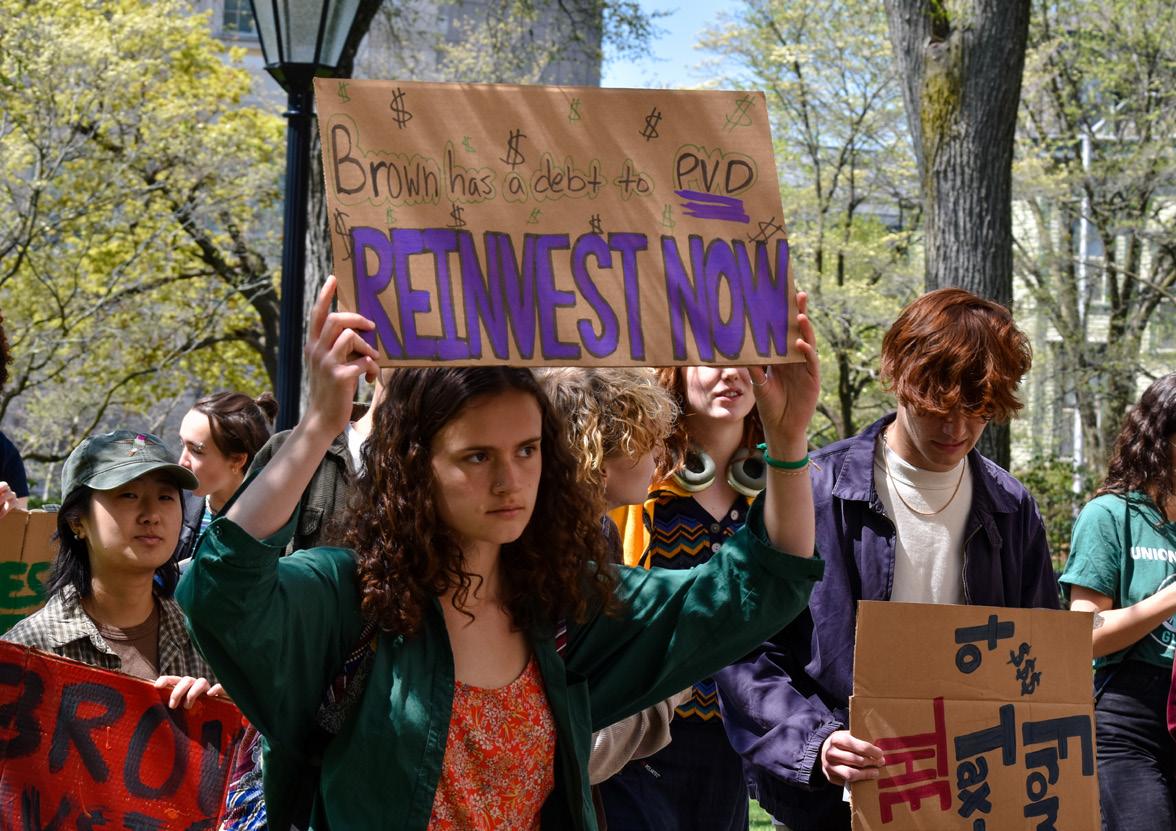
letter called on the University to support two bills in the Rhode Island State House, H5782 and H5603, which would levy taxes on University property and the endowment, respectively.
The letter also called for additional financial support for the city’s K-12 schools and encouraged the University to increase engagement with the Providence community, such as by expanding public access to University libraries.
Students from various student activist groups attending the event echoed their support for the rally’s
message.
“We all have a vested interest together in participating in this rally and urging the University to contribute more to the city,” said Isabella Garo ’24, a Sunrise Brown organizer.
“We’re right here, we’re going to be with SEE and all groups that are supporting this issue,” said Ethan Drake ’24, another organizer with Sunrise Brown.
“Our causes appear different on the surface, but ultimately, they are inextricably linked,” said Jack Doughty ’23, a Brown Students for Justice in Palestine organizer.
SPORTS
Men’s lacrosse falls to Cornell 16-9, celebrates seniors, 1973 alumni
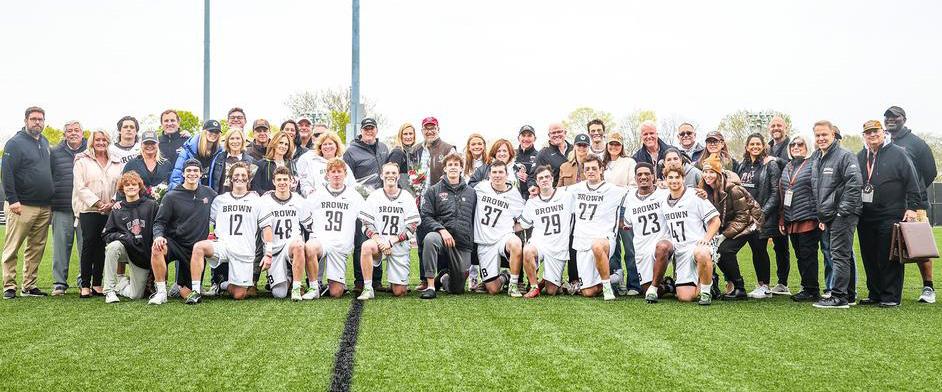
Loss is team’s fourth in Ivy League play with two games remaining in season
BY DENNIS CAREY SENIOR STAFF WRITERThis Saturday, the men’s lacrosse team (5-7, 1-4 Ivy) lost to No. 6 Cornell (10-2, 4-1 Ivy) at home on senior day. Despite brief runs from the Bears in the first and third quarters, Cornell was dominant in the latter part of each half to hand Bruno their fourth loss in Ivy League play.
“We made some early plays and … we made a few mistakes,” Head Coach Mike Daly said. “They punished us on those mistakes but our team never quit. They kept battling.”
After the game, the Bears recognized the seniors who played their last home game for Bruno.
The team also celebrated the 1973 men’s lacrosse team — who went undefeated in Ivy League Play and played in the NCAA tournament quarterfinals — by bringing some of the 1973 team’s players onto the field during halftime. Announcers joked that these alumni had played with wooden sticks before plastic became the standard.
In the first quarter, Cornell scored almost immediately, taking a 1-0 lead after only 31 seconds of play. The Bears battled back with goals by Matteo Corsi ’25 and Wells Bligh ’25 in the third and fifth minutes respectively to give Bruno an early 2-1 lead. Cornell equalized in the seventh minute, but Corsi gave the Bears a 3-2 lead with his second goal of the game in the eighth.
The Bears conceded four goals to close the first, and despite a breakaway by Griffin King ’23 to close the quarter, the Bears trailed 6-4 at its
conclusion.
The third quarter was the Bears’ best of the day. Bruno outshot the Big Red 16 to six, outscored Cornell and won five of the six faceoffs. Though Cornell was the first to score, Bruno fired back with a goal from attacker Devon McLane ’23 to make it 12-7. McLane’s goal was followed by a score from midfielder Tanner Burns ’25 and then a second McLane goal, bringing the score to 12-9.
It looked to be all Bears in the third after the 3-1 run, but the Big Red fired back in the last minute to
make it a 4-point game.
“They scored the first goal. You know, then we went on a three-one run and we were making plays. We’re doing what you need to do,” Daly said.
“Just (Cornell) answered it. And they had the answers today, and that’s what good teams do.”
Despite the Bears’ run early in the first and third, Cornell dominated in the second, outscoring Bruno 5-2. Cornell put the final nail in the coffin in the fourth, shutting the Bears out and scoring thrice to win 16-9.
Daly lamented the loss as he felt
COURTESY
“like we’ve let (the seniors) down.”
After the game, the Bears seniors were brought out onto the field in front of their families and friends with a slideshow of their lacrosse careers.
“We really just can’t thank them enough,” Daly said. “(We’re) appreciative of everything they’ve done for this program.”
The Bears will end their season on the road with a game at Bryant tomorrow and the season closer on Saturday at Dartmouth. The games will be televised on ESPN+.
Florence + the Machine brings listeners underwater with new single
BY SOFIA BARNETT UNIVERSITY NEWS EDITOR
Last Friday, English indie rock band Florence + the Machine propelled listeners down to new depths with the release of their latest haunting single, “Mermaids.” Cut from the group’s fifth LP “Dance Fever,” the song now joins the album’s “complete edition” nearly a year after its initial release.
The group, led by London-born singer Florence Welch, teased its newest single two weeks prior to its release in a 21-second clip of Welch in a candle-lit bathtub sporting a glimmering mermaid tail and singing the song’s first verse. The teaser begins with Welch singing earnestly, hands to chest, her piercing vocals descending from a sea of serenity to a raging undercurrent. The clip ends with Welch slowly submerging completely underwater as the music intensifies.

The song begins with siren-like harmonies from Welch. Classically trained and well-known for her vast vocal capabilities, Welch’s tonal acrobatics lure in listeners and keeps them mesmerized through her entrancing high notes and powerful low belts.
She is remarkable in her ability to catch the attention of new listeners while also enthralling long-time fans. On top of producing yet another vocally stunning song, Welch masterfully crafted a storyline brought to life through her music — both in direct lyrical references to past hits and in her dark fairytale aesthetic.
Starting off strong, the song’s intro — “I thought that I was hungry for love / Maybe I was just hungry for blood” — is a direct reference to “Hunger,” a song from the band’s
fourth studio album, “High as Hope.” But the band quickly moves on to set the scene, beginning — as Welch often does — with a spiritual reference that adds a sacredness to the sound. The following lyric, “Seafoam woman on the shore,” is an allusion to Aphrodite, the Greek goddess of beauty and love, whose legend claims she was born from seafoam on the island of Cyprus.
While this reference may leave listeners expecting a love song, the intro’s final line gives listeners a better idea of what they’re actually getting into: “All the mermaids have sharp teeth / Razor blades all in your feet.”
This jarring imagery mirrors the grim fairytale of “The Little Mermaid,” written by the father of mystical storybook horror, Hans Andersen. In this morbid story, the wistful mermaid exchanges her tail for legs to pursue a human above water but is cursed by the sea witch to feel “as if treading upon the points of needles or sharp knives” with every step.
In a fascinating transition, the song melts into its verses, immersing listeners into a young Welch’s party days in her English homeland.
Welch can’t separate the glamorous lifestyle of “huggin’ girls that smelled like Britney Spears and coconuts” from the “mermaid hair” and “teeth so sharp,” a reminder of how Welch’s hunger for acceptance conflicts with — and possibly even strips away — her humanity.
This self-destructive search for connection is most evident in the chorus, a hallowed chanting of the “cheerful oblivion” Welch lived in. Welch’s insertion of nostalgic longing is a compelling lyrical risk. In merging personal memories with this unsettling reprise of a classic child’s tale, Welch strings together a smartly woven narrative of her experiences with living life in “cheerful oblivion,” hidden within the lines of captivating folklore.
The commitment to this oblivion introduced in the third verse — “You only get one night upon the shore / So dance like you’ve never danced before” — is not an unusual idea for the band. In fact, several tracks on “Dance Fever” — including “Free” and “Choreomania” — directly convey the singer’s willingness to honor celebratory expression through her body, fully devoting herself to the feeling. But letting loose has a dark side, “And the dance floor is filling up with blood.”
The bridge ties the song together perfectly, describing how the mer-
maids emerge once a year “to sacrifice a human heart.” In the original telling of “The Little Mermaid” by Andersen, the sea witch offers the mermaid a loophole for if she were to fail in winning over the prince — her life could be spared if she could stab him in the heart.
Though in Andersen’s telling, the loveless mermaid chooses to not stab the prince, Welch’s mermaids are not bound by the same reluctance. The mermaids chose to sacrifice others rather than abandon their reckless pursuit of an unattainable love year after year, reminiscent of the stoic
lifestyle Welch describes in “King,” also on “Dance Fever.”
From lyrical artistry to vocal and instrumental divinity, members of Florence + the Machine have again proven themselves as sorcerers of musical storytelling and avant-garde audio. The last minute of the song is devoid of lyrics — just a gut-wrenching blend of deep percussion, eerie brass and suspenseful strings that fade out gently, as if dragging the listener into a “cheerful oblivion” of their own, lulled to the seafloor by Welch’s unwavering golden voice and hypnotic lyrical genius.
‘Mermaids’ added to band’s fifth LP ‘Dance Fever,’ alludes to ‘The Little Mermaid’COURTESY OF STEVE COLLIS VIA WIKIMEDIA COMMONS The song was originally written for the band’s fifth LP “Dance Fever,” but was cut from the record’s initial release a year ago.
Konigsmark ’26: ExxonMobil lied on our campus — will we invite them back?
In October 2022, nearly 60 student protestors showed up to an ExxonMobil recruiting event hosted on Brown’s campus. Their demand? That ExxonMobil takes its deception and destruction elsewhere.
Despite ending endowment investments in fossil fuel extraction in 2020, the University continues to host fossil fuel industry recruitment events and its researchers continue to accept grants from fossil fuel companies. At these events and through job postings for students, fossil fuel companies advertise themselves as socially responsible while simultaneously advancing science disinformation. Inviting fossil fuel companies to campus is therefore in direct contradiction with the spirit of Brown’s business ethics policy, which states that “the University will not conduct business with individuals and organizations that directly support the creation and dissemination of science disinformation.” To truly live up to its promises of sustainability and academic integrity, Brown must implement a fossil-free careers policy that bans fossil fuel companies from recruiting on campus, posting job openings and otherwise advertising to students through Brown.
When ExxonMobil recruited on Brown’s campus in 2022, the event’s description claimed that the company had “recently reconfigured to focus on diverse energy sources.” This is simply not true: In 2021, only an estimated 0.16% of ExxonMobil’s expenditures went toward low-carbon investments. ExxonMobil’s misleading, climate-friendly rhetoric is part of the industry-wide tactic of “greenwashing,” a practice in which fossil fuel companies overemphasize their minuscule investments in low-carbon projects to distract consumers from their destructive business models. Greenwashing, while not outright lying, is intentionally misleading.
ExxonMobil isn’t the only company that spreads climate disinformation through Brown’s channels, and recruiting events aren’t the only medium they use to do it. Right now, BP’s job postings on Handshake — a platform that institutions like Brown can control
and customize — claim it is “leading the way in reducing carbon emissions,” even though the company backed off its emissions targets in February amid soaring oil profits. Shell’s Handshake job postings brag about investing in “low-carbon sources such as wind and solar,” when the nongovernmental organization Global Witness could identify only 1.5% of the company’s 2021 expenditures as going toward wind and solar energy development.
Campus recruiting events and misleading
In recent years, fossil fuel companies have adopted more subtle forms of disinformation. From 2004 to 2006, BP embarked on a $100-million-plus per year marketing campaign introducing consumers to the idea of a “carbon footprint,” deliberately shifting climate responsibility from corporations to individuals. Similarly, a 2020 Shell television ad featured “the CEO of a Shell renewables subsidiary saying she’s ‘made the future far cleaner and better for our children,’” Oreskes and Supran wrote in
sil fuel companies maintain their image as part of a socially responsible industry. Brown has great influence, so a vocal fossil-free careers policy would profoundly shift the narrative around fossil fuel companies and their deceitful tactics. Once we as a society deny the fossil fuel industry the legitimacy we grant to other businesses, fossil fuel companies will be forced to change their business models or cease to operate.
job postings are weapons in the fossil fuel industry’s 40-year war on climate science. Harvard professor Naomi Oreskes and post-doctoral research fellow Geoffrey Supran’s peer-reviewed research documented that as early as 1978 Exxon’s own scientists knew that burning fossil fuels causes global warming. But Exxon and its successor ExxonMobil have since aggressively cast doubt on climate science, promoting a narrative that contradicts that of virtually all climate scientists. SLB, an oilfield services company that hosted a recruiting event through CareerLAB last fall, has similarly promoted disinformation as a member of the American Petroleum Institute. API has intentionally misled the public on climate science since 1980 to such an extent that the U.S. House of Representatives singled them out in a climate disinformation investigation.
the Guardian. In the ad, fields of wind and solar farms — again, representing just an alleged 1.5% of Shell’s expenditures — glistened while fossil fuels were glaringly absent.
At first, the fight for fossil-free careers may seem small in scope. After all, only around a dozen interested students came to ExxonMobil’s recruiting event last fall. But the consequences extend well beyond disinformation on Brown’s campus. The burning of fossil fuels is responsible for over 75% of general greenhouse gas emissions and nearly 90% of carbon dioxide emissions specifically. And this is not just about green spaces and preserving the environment for its own sake: As a direct consequence of the continued burning of fossil fuels, more than a billion climate refugees could be forced from their homes by 2050.
Respected institutions like Brown help fos-
Many of my peers have expressed concern that a fossil-free careers policy would infringe upon student autonomy. Though I similarly struggled with this question initially, I now firmly believe that a fossil-free careers policy that upholds Brown’s commitment to sustainability and scientific truth can be achieved without compromising students’ freedom to work in the industry of their choosing. Birkbeck, University of London, one of four U.K. schools to adopt a fossil-free careers policy, has demonstrated the feasibility of striking the balance between student autonomy and sustainability. Birkbeck career services’ Ethical Careers Policy promises that they will not hold relationships of any kind with fossil fuel companies, but that students will continue to receive “impartial one-to-one careers guidance on any industry of their choosing.”
I came to Brown in part because I believed it was committed to a sustainable future and to integrity and truth. I love this University and am proud of our ambitious climate goals, but if Brown wants to be remembered as a climate leader, the time for a fossil-free careers policy is now. Until it implements such a rule, Brown’s inaction continues to endanger its students’ futures and gives an unmoderated platform to a uniquely dangerous and deceptive industry.
Augustus Konigsmark ’26 can be reached at augustus_konigsmark@brown.edu. He is a member of Sunrise Brown. Please send responses to this opinion to letters@browndailyherald.com and other op-eds to opinions@browndailyherald.com.

LETTER TO THE EDITOR
John Owen Habib Memorial
To the Editor:
The Office of the Chaplains and Religious Life warmly invites the Brown University family to a gathering of remembrance and celebration for John Owen Habib ’24, on Thursday, April 27 at 4:00 p.m., at the First Unitarian Church of Providence at 1 Benevolent St. All are welcome. A light reception will follow. The service will also be live-streamed for those unable to join in person.
The Office of the Chaplains and Religious Life
“Brown’s inaction continues to endanger its students’ futures and gives an unmoderated platform to a uniquely dangerous and deceptive industry.”
sunset by two years to March 1, 2026.
“This is just a remarkably critical component of the continuum of care for the folks that we serve, and they’ve been underserved for so very long,” said Linda Hurley, president and CEO of CODAC. “If we can get this done and show that we have created a positive change, then this is going to be a model for a whole lot of people.”
There are currently two overdose prevention centers operating in the United States — both in New York City — but neither has explicit legal authorization from the state of New York or the federal government. In 2021, the U.S. Department of Justice blocked plans for another center in Philadelphia, arguing that it would violate federal law.
Parker Gavigan, director of communications for the Providence City Council, wrote in an email to The Herald that the Council and Project Weber/RENEW representatives will meet next week for discussions about the center.
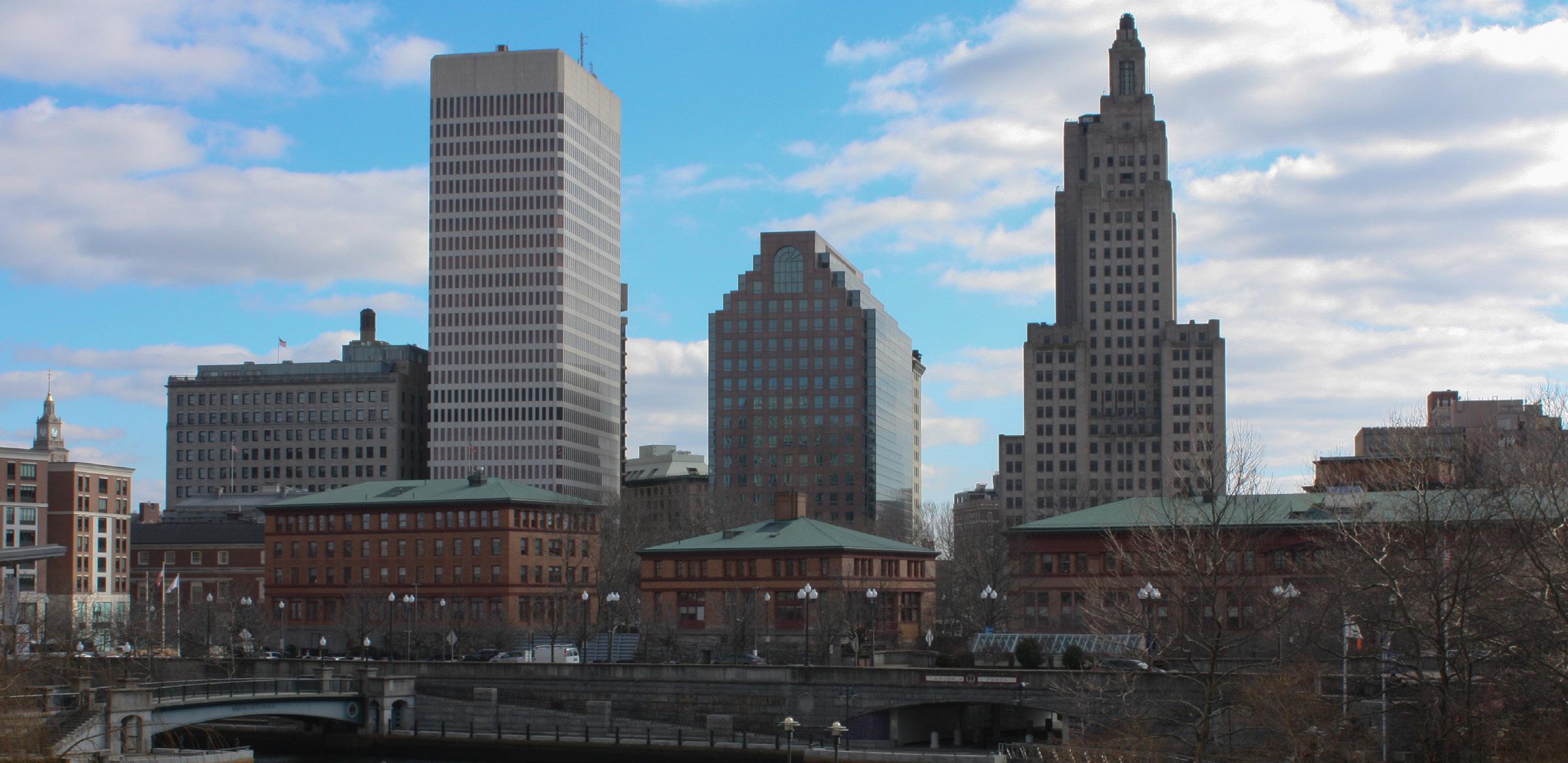
Hurley said that meetings next week with the City Council will include Ward 15 Councilman Oscar Vargas visiting the proposed site at 349 Huntington Ave., which lies in the ward he represents. Gavigan confirmed that the visit is one of “several meetings scheduled for next week.”
Dennis Bailer, the overdose prevention program director at Project Weber/RENEW, said he believes a council vote on the issue will occur within a couple of months “at most” and that he was confident the plan has enough support on the council.
“I’m excited just to be able to really be there for people who use (illicit drugs) in a way which has nev -
er been done in our country,” said Bailer, who will become a co-director of the center when it opens.
According to the press release, The People, Place & Health Collective at Brown’s School of Public Health will conduct “a rigorous evaluation” of the program in order to measure “individual and community outcomes.”
After the pilot concludes, Bailer said that he hopes the data gathered will show that the center reduces overdose deaths “first and foremost” as well as Emergency Medical Services run costs, public usage and drug paraphernalia litter.
Hurley emphasized that the project remains in the early stages of development. She said policies and protocols for the site still need to be developed and medical consultation still needs to be hired.
The location itself will also require significant “buildout,” she added.
The construction will include the demolition and reconfiguration of the location’s first floor to build the injection and inhalation rooms, according to Bailer. There are also plans to add additional showers, bathrooms and laundry facilities, he said.
The location is neighbored by a salvage yard, a used car lot and a passenger railway, but no residences, according to Hurley.
Project Weber/RENEW and CODAC have also begun outreach to Providence community members about the project.
According to Bailer, Project Weber/RENEW is planning to conduct door-to-door canvassing as well as a community cleanup in May around the proposed site. He added that
there were also potential plans to put in plants and murals around the location to make the area “more welcoming” and “vibrant.”
Clients will be able to seek treatment for HIV and Hepatitis C, as well as wound care and other necessary medical referrals at the center, Bailer said. Wound care has become particularly important with the increased presence of xylazine — an animal tranquilizer known to cause severe tissue damage — in Rhode Island’s drug supply.
“It’s such a wide range of services for people who otherwise aren’t going to seek out those services” due to stigmatization, Bailer said.
Bailer added that one of the goals of the center is to keep people engaged and “in the space as long as possible,” whether they be showering
and doing laundry, filling out housing and job applications or playing card games or watching movies, he explained.
This engagement “will encourage people, when they’re ready, to know that they can trust us to get them in other places” for treatment, Bailer said.
“No one who has substance abuse disorder had that as their dream,” said Bailer, who is in long-term recovery himself. “We had other dreams. And those dreams don’t go away for most of us. Those dreams remain in our thoughts.”
Bailer added that repeated criminalization and stigmatization have not been effective in addressing the opioid crisis.
“Let’s try something else and see what the numbers show,” he said.
“I’m excited to be in a place where people seem to really care, and they recognize the good and the bad of where they are and try to improve it,” she added.
“They’re showing the incoming freshmen that this is what Brown is,” ADOCH attendee Maurice Silvera told The Herald while watching the protest.
On the Main Green, Brown Students for Justice in Palestine hung banners reading “End Israeli Apartheid” and “Brown Divest.”
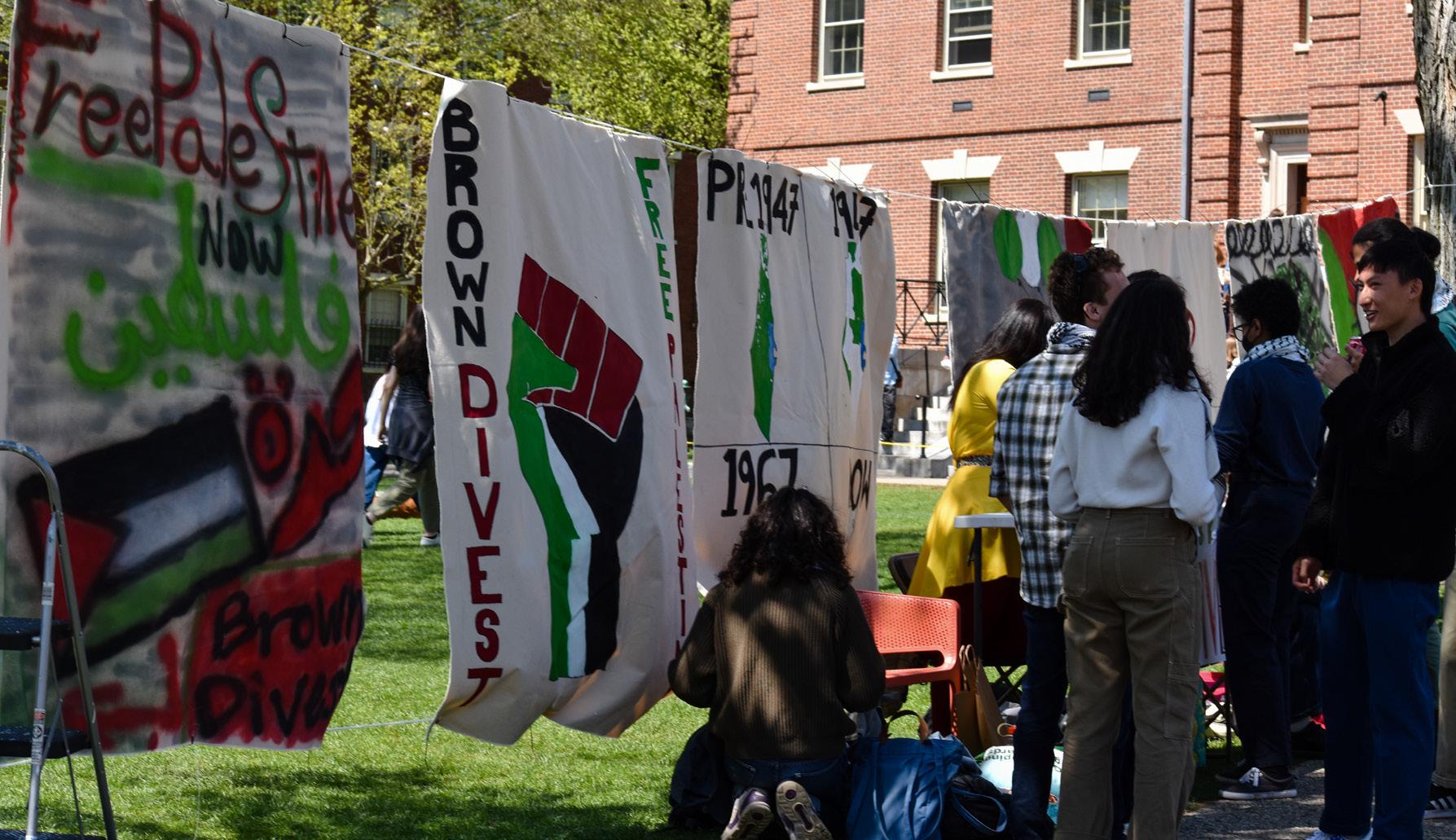

According to Jack Doughty ’23, an SJP organizer, the installation was part of the group’s larger effort calling for the University to divest its endowment from “violent industries that perpetuate human rights abuses, both in Palestine and globally.”
“Brown is deeply committed to academic freedom, and we will continue to uphold the right of members of the Brown community to express their views on the Israeli-Palestinian conflict,” President Christina Paxson P’19 P’MD’20 wrote in a March 2021 letter to the University community. “We will not use the endowment to take an institutional position on this issue.”
“We want incoming and prospective students to be aware of what it’s like trying to actively engage in organizing” on campus, Doughty added.
Between two trees on the Main Green, the Dream Team — an on-campus organization dedicated to immigration advocacy and community-building — displayed a banner reading “No one is illegal on stolen land.” The organization hoped that its banner would allow admitted students who identify as undocumented to “know that there’s a space
for them” at Brown, said a member of the organization who asked to remain anonymous because of their undocumented status.
Brown Votes and Brown Students for Israel also set up tables on the green.
“We want to spread information, share food, share flyers, talk about (the) culture of Jewish life and pro-Israel life on campus for parents and for students who are potentially coming to campus,” said Jillian Lederman ’24, president of Brown Students for Israel and former contributing writer for The Herald.
“It’s a wonderful thing for admitted students to see how active and engaged current students are,” Powell said, adding that he hoped prospective students would “walk away with a clearer sense of what makes the Brown community so special.”
Brittany Narvauz, a prospective student, said that she most enjoyed the speed friending event, while attendee Hannah Park called Zia’s presentation on the open curriculum a highlight from the day. Other attendees cited the tours of Keeney Quadrangle and the local food trucks serving lunch as their favorite aspects of ADOCH.
Students who were unable to attend the event can explore virtual programming on the “Bruniverse,” an online platform for admitted students, Powell said.
Powell added that he hopes this event allowed students to “really imagine what their lives would be like as Brown students for four years.”
Latinx Students in Business and Leadership club visits Harvard, MIT
Trip participants hear from professors, tour campuses, speak with current students
BY EMILY FAULHABER UNIVERSITY NEWS EDITOROn April 14, the Latinx Students in Business and Leadership Club led a trip to Harvard Business School and Massachusetts Institute of Technology
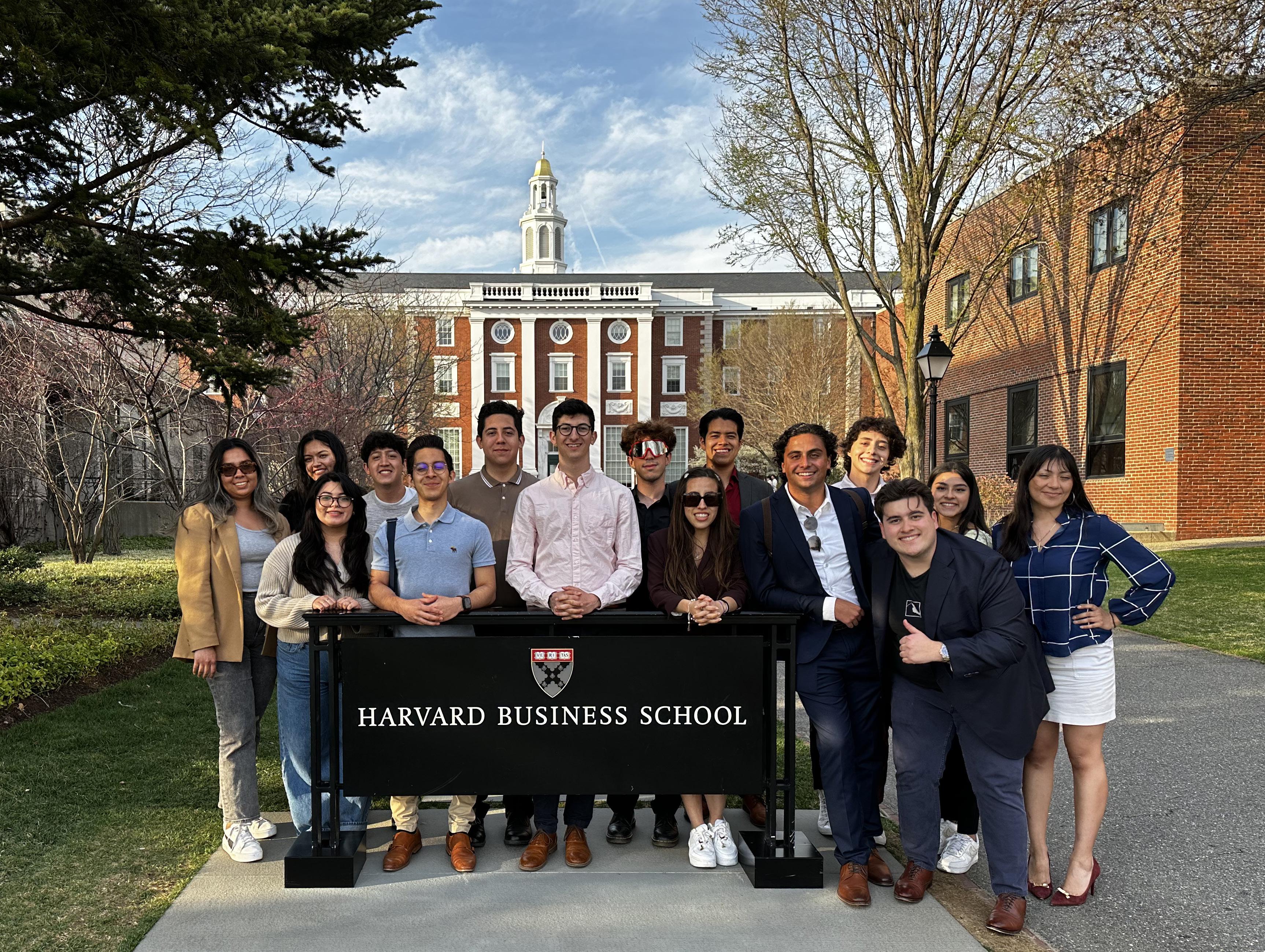
Sloan School of Management.
15 participants had an “exploratory experience” where they could sit in on a class, go on a campus tour and meet with students at each respective university, said Ben Hokenson ’24.5, co-president of LBL. The trip was open to anyone that identified as Latinx, not just club members, Hokenson said.
Hokenson first reached out to HBS and MIT last August to start planning the trip. Upon arrival at HBS, participants met with student ambassadors to learn more about the business school.
In an HBS class, trip members were able to participate in a case study on Nokia, said Ishan de Campos Unni ’25, trip participant and club member. He added that he appreciated that the classroom was decorated with flags from all the different countries represented by HBS students.
“I’m from Brazil, and (it) was really important for me to see the representation from all parts of the world,” he said.
HBS classes are organized into cohorts of around 90 students, which makes it so everyone “knows each other pretty well,” said Tania Gutierrez Espinosa ’24, LBL co-president.
Cohorts are intentionally made with students from different backgrounds with varying viewpoints, which creates “rich” classroom discussions, she said.
Trip participants also learned about
SINCE 1891
the various professional backgrounds that HBS students had before going to business school, from engineering and technical banking to bartending, de Campos Unni added.
“It was a really interesting mix of people, and (the class) was really well guided by the professor who knows (every student) and how they can contribute to the conversation,” de Campos Unni said.
At the MIT Sloan School of Management, LBL members met with the school’s director of D&I and “a few
students from their Hispanic business club,” Hokenson said. Gutierrez Espinosa said it was helpful to hear the students talk about their “non-traditional” journeys to MIT.
The group went on campus tours at both schools. De Campos Unni felt that the student-led tour and information session at HBS was “super helpful.”
At MIT, the group had a private information session organized by Hokenson to learn more about the school’s admissions process, financial
THE BROWN DAILY HERALD
Head Opinions Editor
Alissa Simon
Opinions Editors

Anika Bahl
Bliss Han
Melissa Liu
Jackson McGough
Multimedia

Illustration Chief
Ashley Choi
Photo Chiefs Elsa Choi-Hausman
Dana Richie
aid and programs of study. The group then went on a campus tour led by a Latino student. In comparison to the tour at Harvard, Gutierrez Espinosa appreciated how the MIT tour was more “personalized” to the group.
Reflecting on the trip to both business schools, de Campos Unni said, “I feel like (there) is this … closed view of what the world outside of (Brown) is going to look like” but many of the students attending the business schools had “super unconventional trajectories.”
He also added that the trip “opened” his view on business school and showed that the “environment” of a business school contributes to students’ success.
Gutierrez Espinosa said she is excited about the possibility of the “relatively new” club, which was founded in 2021, going on more trips in the future.
“It was good to get really close with people from all different (years),” de Campos Unni said.
“A lot of people were left very inspired” by the trip, Hokenson added.
Submissions: The Brown Daily Herald publishes submissions in the form of op-eds and letters to the Op-eds are typically between 600 and 900 words and advance a clear argument related to a topic of campus discourse. You can submit op-eds to opinions@browndailyherald.com.
Letters to the editor should be around 250 words and respond to an article or column that has appeared in The Herald, or critique or commend The Herald’s editorial decisions. You can submit letters to the editor to letters@browndailyherald.com.
Emily Faulhaber
Coco Huang
Alyssa Sherry
Kaiolena Tacazon
Production
Copy Desk Chief Brendan McMahon
Design Chief Neil Mehta
Design Editors
Sirine Benali
Maddy Cherr
Ashley Guo
Gray Martens
Holleb
Sam Levine
Neil Mehta
Haley Sandlow
Kathy Wang
Digital News Director of Technology
Swetabh Changkakoti
Opinions
Editorial Page Editor
Kate Waisel
Photo Editors Mathieu Greco
Claire Diepenbrock
Lilly Nguyen
Kaiolena Tacazon
Social Media Chief
Sahil Balani
Social Media Editors
Julian Beaudry
Nadia Bitar
Business
General Managers
Joe Belfield
Andrew Willwerth
Sales Director
Alexander Zhou
Finance Director
Eli Pullaro
Submissions undergo multiple rounds of editing. These rounds of editing generally take place over the course of one evening, and you may have to respond to edits late in the evening. If you know you will be unable to do so, please mention that in your email, and we will do our best to work with you.
Submissions can build on reporting from The Herald, reporting elsewhere, official statements from the University or other groups and other reputable sources, but they cannot break news or contain information that The Herald cannot verify. Because we cannot publish unsubstantiated information, failure to provide appropriate sources may mean we have to modify or remove unverified claims.
The Herald will not publish anonymous submissions or submissions authored by organizations. Leaders of student organizations can be identified as such but cannot write under the byline of their organization.
The Herald cannot publish all submissions it receives and reserves the right to edit all submissions.
All submissions to The Herald cannot have been previously published elsewhere (in print or online — including personal blogs and social media) and must be exclusive to The Herald. Once your submission is published in The Herald, The Brown Daily Herald, Inc. owns the copyright to the materials.
Commentary: The editorial is the majority opinion of the editorial page board of The Brown Daily Herald. The editorial viewpoint does not necessarily reflect the views of The Brown Daily Herald, Inc. Columns, letters and comics reflect the opinions of their authors only.
Corrections: The Brown Daily Herald is committed to providing the Brown University community with the most accurate information possible. Corrections may be submitted up to seven calendar days after publication. Periodicals postage paid at Providence, R.I. Postmaster: Please send corrections to P.O. Box 2538, Providence, RI 02906.
Advertising: The Brown Daily Herald, Inc. reserves the right to accept or decline any advertisement at its discretion.
The Brown Daily Herald, Inc. is a financially independent, nonprofit media organization bringing you The Brown Daily Herald and Post- Magazine. The Brown Daily Herald has served the Brown University community daily since 1891. It is published Monday through Friday during the academic year, excluding vacations, once during Commencement and once during Orientation by The Brown Daily Herald, Inc. Single copy free for each member of the community. Subscription prices: $200 one year daily, $100 one semester daily.
Copyright 2023 by The Brown Daily Herald, Inc. All rights reserved.
nounced a push to remove graffiti, add “more attractive trash cans” and make general cosmetic improvements to the street.

A few years later, the Thayer Street District Management Authority was established in January 2006. The TSDMA oversees the management and maintenance of the area bounded by Bowen, Brook and Waterman streets.
Donna Personeus, who has served as executive director of the TSDMA since 2014, said that the organization was founded by a group of property owners who wanted to work as a team to address issues like graffiti removal, sidewalks, lighting, landscaping and more.
Ali Burns-Nachwalter, who opened her boutique NAVA on Thayer in 2008, said that the street has become “commercialized” since her arrival, pointing to the replacement of small businesses with chain restaurants.
Today, Thayer is “starting to feel like an outdoor food court,” Burns-Nachwalter said.
Ben & Jerry’s originally opened just off Thayer on Meeting Street in May 1988, and the ice cream shop relocated to Thayer in November 2013, wrote Alexa Harrison, public relations manager for the store, in an email to The Herald.
With “a long-standing presence” on the street, the ice cream shop’s current location in the former Symposium Books space retains the original marble of the building, helping to preserve its history, wrote Senior Business Consultant Ben Soisson in an email to The Herald.
All Ben & Jerry’s shops are locally owned and operated, and “we’re so happy to have secured a reasonably affordable location on busy Thayer Street,” Soisson wrote.
Ed Davis, chef and general manager of former Thayer staple Durk’s Bar-B-Q, first came to Providence 18 years ago. Even then, locals would tell him that the street “ain’t what
it used to be,” he wrote in an email to The Herald.

But for Richard Dulgarian, owner of the Avon Cinema, the turnover has brought benefits without erasing the street’s unique character.
“It’s also become a gourmet’s delight,” he wrote in an email to The Herald, recalling that in the 1970s, the street had only two restaurants: Rascal House and The Hungry Sheik. “Now, there are dozens (of restaurants) that would satisfy every culinary palate,” he wrote.
Both Davis and Dusseault left Thayer by 2020, while Dulgarian remains today.
To Thayer or not to Thayer?
Local businesses rely on foot traffic to bring customers in and low rents to keep costs manageable. But rising rents and larger competitors have pushed some businesses off Thayer Street.
For small business owners like Davis, locations off of Thayer Street can accommodate more patrons and offer lower rent costs.
While Durk’s Bar-B-Q was on Thayer Street, finding parking was “a huge issue” for patrons and managers alike.
When the Brown-owned parking lot on Brook Street — now the location of the Sternlicht Commons and Brown University Health and Wellness Center — was closed in 2019, Davis wrote that his restaurant experienced a drop in sales.
The parking lot’s closure was “the final nail in the coffin,” he wrote, and it “made moving a much easier decision.”
In late 2019, Durk’s moved off of Thayer Street and onto Aborn Street in downtown Providence. Since then, the store has seen “more of everyone coming into the restaurant.”
Davis cited not having to compete with the “fast, casual stuff on Thayer” as another plus of the new location.
“It’s kinda nice not being nestled between Chinatown (on Thayer) and Baja’s and right across the street from East Side Pockets,” he wrote.
After opening in 2008, Burns-Nachwalter’s NAVA sustained “pretty strong” business for its first five years. But nearby construction for the street’s 257 Thayer apartments added to parking challenges for non-student patrons, making it harder to attract them to the boutique, she said.
“I didn’t want to be primarily a store for college students,” she noted, adding that “our customer demographic was avoiding Thayer at all costs.”
In 2015, NAVA left Thayer for Wickenden Street, where it remains today. With the move, Burns-Nachwalter gained access to a bigger space, parking for patrons and a community of small businesses that work together, she said. Today, Burns-Nachwalter is part of the Wickenden Area Merchants Association, a group of small businesses on or near Wickenden Street.
Dusseault first came to Thayer Street in 1995 from the adjacent Angell Street when a new lot opened. Dusseault said that she “jumped” at the opening, even though the property had a far higher rent than her original location.
Dusseault said that the new location provided her store “substantially more traffic,” setting up Pie in the Sky for another 25 years of business. But the store eventually shuttered in 2020 following pandemic-related challenges and rising costs, The Herald previously reported.
Dusseault said that decreasing business — compounded by the rise of online shopping — and high rents on Thayer Street convinced her that the location was “a dead end.”
After Pie in the Sky closed, she opened Old Bag Vintage on Ives Street. Since then, business “has been going well,” she said.
On Ives, not only is rent lower, but Dusseault can afford more time off, which was rare on Thayer. Old Bag Vintage is closed on Mondays and Tuesdays — as are most businesses on Ives Street.
Longevity on Thayer
Some Thayer storefronts today — by virtue of their business models and popularity — have remained on the street for decades.
Thayer’s longest-standing institution, the Avon Cinema, draws on its own history to stay afloat.
The theater, which has been on Thayer for 85 years, has been owned and operated by the Dulgarian family since its opening. “People crave the familiar, the memories of a past experience,” Dulgarian wrote.
And after a slump in sales due to the pandemic, business has been picking up, he wrote.
Bud McCann, owner of Thayer’s franchised Allegra Marketing Print Mail since 2021, said that the store’s business model has contributed to its longevity. Allegra was previously known as Jo-Art Printing and Copy Service and has been on the street since before 2000.
Allegra’s clients are typically organizations — with the majority being University departments — instead of individuals, so foot traffic and location aren’t essential factors in attracting customers, McCann explained.
But even McCann’s business was not immune to pandemic-related challenges. At the height of COVID19’s spread, revenue dropped around 26%, he noted.
Wassim Chedid, owner of Salon Persia, said that the salon’s original owner, Mario Persia, opened the salon on Thayer in 1972 because “it was the street to be at.”
Chedid started working at the salon in 2000 and took it over when Persia retired in 2003.
Though the store faced pandemic-related challenges, Salon Persia’s client demographics have remained relatively consistent throughout the years, with a mix of residents, faculty and students.
Turnover on Thayer
Though some stores have remained, Thayer Street in 2000 was radically different than it is today.
Eleven businesses — Salon Persia, Supercuts, East Side Pockets, Berk’s, Andrea’s, the Brown Bookstore, Kabob and Curry, Starbucks, Allegra, CVS and Avon — have been on the street since 2000. But 51 others that existed in 2000 can no longer be found on Thayer.
Most recently, the street has welcomed Yas Chicken and Tiger Sugar, while Blue State Coffee and Ayame Hibachi Express have shuttered. As of April 2023, Pokeworks — currently at 213 Thayer St. — is set to reopen across the street at 212 Thayer St. Future of Thayer
With storefronts continuing to come and go, the future of Thayer Street remains to be seen.
“There’s a lot of turnover on Thayer Street,” Dusseault said. “The rent is very high … small shops don’t open there anymore because it’s too much.”
Burns-Nachwalter added that the street has evolved to take on a “corporate” character. Today, it has more big businesses and less community for small ones, she said.
“There’s a misconception that there are a lot more corporations (than) small businesses. I disagree with that to an extent,” Personeus said. “A lot of what is perceived to be a chain is owned by a local family.”
“You’re gonna love the Thayer that you fell in love with,” Personeus said. “I fell in love with Thayer when I was in high school, and that was in the late ’70s … I still love it to this day.”
Thayer Street “is going to be what the students and the community want it to be,” Personeus said. “As different influences come through Brown, you’ll see the street reflect that … sometimes (change) happens and you can’t control that cycle,” she said.
Personeus noted that while some may lament the coming and going of certain businesses, for her, this is part of the charm of Thayer. “Another generation of the street is being evolved, is being built,” she added. “To me, that’s kind of a fun thing … What’s coming next?”
Explore The Herald’s interactive timeline:
Wave of graduate labor movements sweeps the country
Graduate student labor unions push for safer working conditions, expanded pay, benefits
BY KATIE JAIN SENIOR STAFF WRITERThough Brown’s Graduate Labor Organization voted for unionization in 2018 and has had a collective bargaining agreement with the University since 2020, a number of organizations at Brown’s peer institutions have only just begun the unionization process.
Graduate student labor movements have progressed nationwide as students advocate for higher wages and stipends, better and more accessible working conditions, support for international graduate students and broader healthcare coverage.
While many of these organizations have been advocating for grad students for years, they are now looking to formalize their roles through official recognition from their universities and the National Labor Relations Board.
Since the start of 2023, graduate students from Dartmouth, Johns Hopkins University, the University of Chicago, Northwestern University and the University of Southern California have voted to unionize.
Formal unionization is pending on other campuses. Duke University’s labor organization filed to hold an election with the NLRB early last month. A majority of Princeton graduate students signed union cards with Princeton Graduate Students United this February, and the Stanford Graduate Workers Union launched its unionization campaign April 3.
Why unionize?
Many of the unions’ demands center around creating safer working conditions and increasing access to health care, particularly in light of the COVID-19 pandemic.
Teachers and Researchers United at Johns Hopkins University began organizing for labor rights in 2015 around “issues related to health insurance,” said Emily Hoppe, a TRU JHU organizer. The union gained traction in 2020 due to COVID-19, she added.
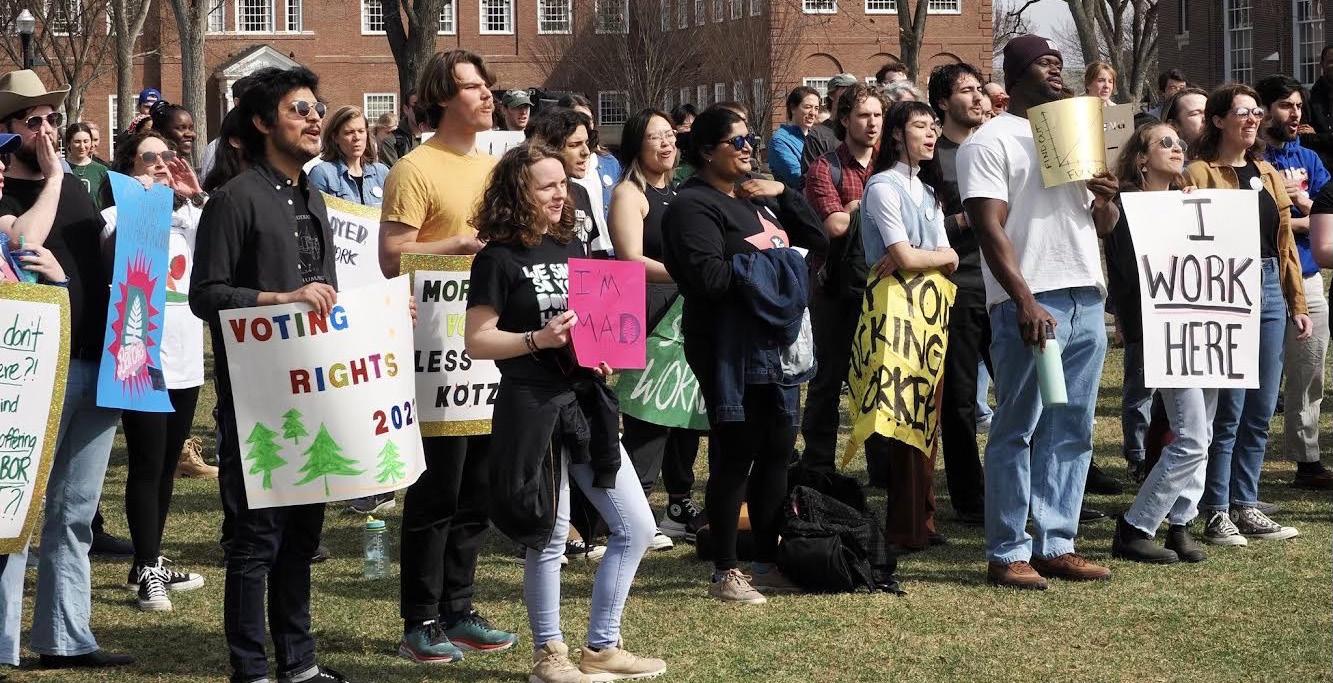
“There were a lot of serious concerns about graduate workers being called back in as essential workers and not feeling that they were being given adequate protection,” Hoppe said. “That reenergized things and really got the ball rolling.”
Similarly, while Northwestern University Graduate Workers formed in 2016, the pandemic “really brought to light a lot of issues that grad workers face,” said Kavi Chintam, a co-chair of and organizer for NUGW. “That helped STEM workers in particular really see how we were being exploited, because we were forced to go into labs earlier than a lot of people wanted to.”
Northwestern graduate student workers voted to unionize in January.
USC’s response to the pandemic brought its Graduate Student Worker Organizing Committee to the same conclusion. “It made people think, ‘I do need a way to protect myself because the university is not looking out for me,’” said GSWOC organizer Yonatan Hirshberg.
The pandemic also prompted Dart-
mouth grad students to form Graduate Organized Laborers of Dartmouth in the fall of 2021.
“Our pay wasn’t increasing to meet the cost of living here, and grad students were acting first out of desperation, but then out of a great hope for the future,” said GOLD organizer Logan Mann.
Graduate student workers at Brown have detailed similar challenges of soaring rent prices and poor housing conditions.
Union certification and challenges
To become officially recognized by the NLRB, unions must either receive voluntary recognition from their employers or conduct an election. To begin the election process, 30% of workers need to sign union cards saying they want a union.
After holding a card drive and gathering support from “well over 1,300” students, the Duke Graduate Student Union requested voluntary recognition from Duke in February, DGSU organizer Matthew Reale-Hatem said. DGSU did not receive a reply and later filed for an election with the NLRB.
In response, Duke is pursuing a legal challenge to a 2016 NLRB decision that ruled that graduate students who work as teaching and research assistants are considered university employees and thus able to unionize. “PhD students are not admitted to do a job; they are selected because of their potential to be exceptional scholars,” representatives of Duke wrote in a statement challenging the decision.
“Duke is not only refusing to work with us and refusing to respect our right to an election, but they’re actually trying to relitigate the status of (all) graduate workers,” Reale-Hatem said. “It is a transparent delay tactic, but it’s also a very dangerous one.”
Duke did not directly respond to requests for comment, instead referring to previous written statements.
“We’re really still hoping for an election this semester,” Reale-Hatem said. But Duke is “claiming that they don’t have space to hold an election during the rest of the semester, which is pretty absurd.”
According to Callahan, GOLD also encountered resistance from Dartmouth in its organizing efforts.
A week before GOLD’s election, Dartmouth announced it would challenge over half of expected ballots because it does not consider many of
the graduate students at Dartmouth to be employees. Dartmouth sent out communications to around 800 grad students encouraging them to vote, despite expecting to challenge many of the students’ ballots, according to Callahan.
In response, GOLD organizers attempted to get the students whose ballots would be challenged “to not vote of their own accord, to boycott the polls and to go to a rally” instead, Callahan said.
“We had just a phenomenal result because people stuck to the plan. … We only got 13 votes under challenge,” Mann said. Dartmouth graduate student workers voted to unionize April 11 and 12 with a 261-33 majority.
That “demonstrated to us that people trust us and they don’t trust Dartmouth,” Callahan said.
The controversy surrounding the election “signaled to us that Dartmouth is willing to use legal dirty tricks to delay this process,” Callahan said. “They are not interested in good faith bargaining.”
Dartmouth did not respond to multiple requests for comment about the election. According to the Office of the Provost’s website, “Dartmouth respects the right of all eligible students to decide for themselves whether they wish to be represented by GOLD-UE.”
“We look forward to working with GOLD-UE and the National Labor Relations Board on the next steps,” Jon Kull, dean of the Guarini School of Graduate and Advanced Studies, wrote in a statement published the day after the election results were announced.
Stanford has been “even-keeled” in its response to organizers’ April 3 unionization announcement, SGWU organizer Jason Beckman said, though they claimed the university put out a message asking faculty not to talk about the union. “That obviously ruffled some feathers (and) had some vocal professors asking, ‘why can’t we talk about the union? We’re supposed to have robust debate here and listen (to) solutions,’” he said.
“We recognize and greatly value the many contributions that graduate students make to Stanford’s mission of teaching and research,” wrote Stanford President Marc Tessier-Lavigne and Provost Persis Drell in a statement issued after the union campaign was announced. “Stanford’s relationship with our graduate students is, first and
foremost, an educational one.”
TRU-JHU, on the other hand, faced no difficulties working with Johns Hopkins administrators, Hoppe said. Senior administrators at Johns Hopkins expressed a similar sentiment in a letter published in February.
After Northwestern graduate students voted in favor of the election earlier this year, the university released a statement emphasizing that “Northwestern deeply values the contributions that graduate students make to its research and teaching missions.”
Negotiations
After certification, each graduate union begins negotiations with its university over its contract. GLO is currently in negotiations for its expiring contract with Brown, The Herald previously reported.
Following its recent election, Northwestern’s graduate union is “now in a stage where we’re about to bargain for our first contract,” Chintam said.
GSWOC had its first contract negotiations with USC April 11 to set ground rules for the rest of the discussions, which will be open to all members of the bargaining unit, according to Hirshberg.
Hirshberg said that GSWOC hopes to come to a “tentative agreement” by the end of the summer but is prepared to “escalate and put more pressure on the university to come to a fair contract” if necessary.
“USC is proud of the substantial support and competitive benefits it provides its graduate students. … We remain committed to bargaining in good faith to reach a fair contract,” wrote USC Vice President for Strategic and Crisis Communications Lauren Bartlett in an email to The Herald.
At Johns Hopkins, TRU-JHU is advocating for a “liveable wage” which, according to Hoppe, is roughly $40,000 per year for a single adult in Baltimore.
“Seeing our colleagues experiencing financial strain, food insecurity, housing insecurity — these are huge motivators for us,” she said.
At Stanford, “graduate students are paying upwards of 40% of their income on rent,” Beckman said. “Personally, my housing was about 45% of what I made every year.”
According to the United States Census Bureau, households that spend more than 30% of their monthly income on housing needs are considered cost burdened.
Many graduate students also emphasized a need for better protections for international workers. “There are a lot of extra legal hoops that international students have to jump through — often very expensive, time-consuming hoops that interfere with their career, like traveling back to countries to renew their visas,” Reale-Hatem said.
Mobilization
According to Hirshberg, USC’s union is preparing for bargaining by “making sure we have solid leadership and participation across every department as we go into contract negotiations.”
At Northwestern, phone banking and walkthroughs have ensured that NUGW maintains a constant presence on campus, Chintam said. The union has also utilized general body meetings, office hours, text banking and emails to reach its community.
At Stanford, SGWU has been “been listening to people, finding out what their needs are — what they need from their working conditions at Stanford and what they would need from a union,” Beckman said.
Due to public support from faculty, the City Council and state representatives, DGSU has been able to “exert a lot of public pressure on Duke,” Reale-Hatem said.
Many of the latest unionization efforts have come from unions associated with United Electrical Radio & Machine Workers of America, a union founded in 1936 which represents thousands of workers across the country. The University of Chicago, Johns Hopkins, Northwestern, Dartmouth and Stanford’s unions are all affiliated with UE.
According to Callahan, because so many unions in similar positions to Dartmouth are also affiliated with UE, “we were all formally part of the same network and could receive information from them and use the same tactics they used.”
Chintam explained that there has been significant “knowledge sharing, time sharing and community building” between NUGW and the University of Chicago’s unions in particular due to the schools’ close proximity. “During the whole election period, we showed up for each other,” Chintam said.
“It’s an absolutely wild wave to be in and it’s been such a privilege to get to witness it,” Mann said. “The future is looking really, really bright for grad student workers.”
